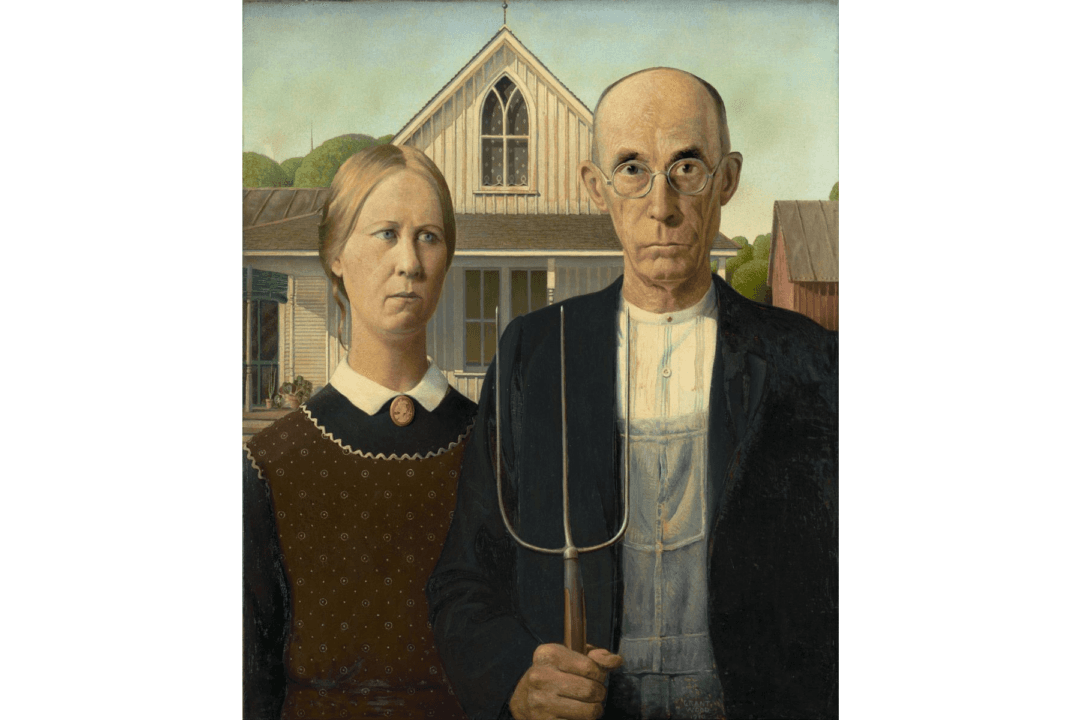Artists can draw inspiration from anywhere or anything: a colorful sunset, a loving couple snuggled on a park bench, a basket of fruit. In 1930, one artist, driving through a small Iowa town in April, was inspired by something unusual.
Driving past a white-framed clapboard house, he saw a medieval-arched window on the second story. The house’s architectural style was known as Carpenter Gothic, or Rural Gothic. Mesmerized by what he considered “a structural absurdity” on such a simple structure, the young artist that he decided it would make a wonderful backdrop for an American heartland scene he imagined. One might say Grant Wood was “drawn” to the house and what it represented in his artist’s imagination.

Regionalism as an Art Genre
Wood was one of three artists primarily associated with an artistic genre known as Midwestern Regionalism, or American Regionalism. The others were Thomas Hart Benton and John Steuart Curry. Sourced primarily in the Midwest, the genre depicted advanced figurative painting of rural American themes, featuring compositional characteristics and intricate techniques. Regionalism depicted objects and persons directly observed.
Picture This
While studying the 3-by-3-inch sketch he had made of the Gothic-style house on the back of an envelope, Wood tried to imagine “the kind of people [he] fancied should live in that house.” He intended to paint the house’s occupants in the foreground with serious and somber expressions befitting their personalities as hardworking, industrious Midwesterners.Wood originally wanted to use his mother, Hattie, as the female figure in the work as the farmer’s wife, but was concerned that posing for an extended time might be too difficult for her. So, he substituted his 32-year-old sister, Nan Wood Graham, to pose as the farmer’s daughter. He warned Nan ahead of time that his portrayal of her would be unflattering because he wanted her plain and old-fashioned looking with a dour expression. To help set the mood, he coached her to imagine the father she lived with was authoritative and strict. Thus advised, Nan went shopping for some plain brown and black fabric to make the dress she planned on wearing for the painting. She also borrowed a cameo brooch and made her own apron, applying rickrack trim from her mother’s old dress.

“It was really difficult because Grant was always joking. And both of us would break into laughter, and then we would have to start all over again. It was hard to go from being Grant Wood’s sister and joking with him in the studio to being a farmer’s daughter standing in front of a house.”
The male figure used in American Gothic was the artist’s 63-year-old dentist, Dr. Byron McKeeby. McKeeby had just the look Wood envisioned for his painting: a long face, strong hands, and a stern countenance. Looks can be deceiving, though; in real life McKeeby was an affable and outgoing gentleman who loved to cruise Cedar Rapids in a red sports car.
American Gothic Interpreted
Upon finishing the painting, Wood had successfully captured the look he wanted and he submitted the painting to the “43rd Annual Exhibition of American Paintings and Sculpture” at the Art Institute of Chicago in 1930. Initially dismissed as a “comic valentine,” an influential museum patron urged judges to reconsider, and Wood was awarded the Norman Wait Harris Bronze Medal and a $300 prize.Wood’s painting became an overnight sensation after dozens of newspapers across the country published pictures of his painting. It also helped anoint him as the leading spokesman for the fledgling Regionalism movement. As often happens with great works of art though, people interpreted his painting differently. Many thought the painting lauded Midwestern values of hard work, perseverance, and a can-do attitude; others thought it was mocking rural people as humorless, grim, and puritanical; still others viewed it as a clever parody.
Whatever initial impression people had of the painting, Wood always intended his painting to be an affirmation of American values, particularly as the country wrestled with issues of unemployment, displacement, and uncertainty during the Great Depression. Indeed, as the Depression worsened in the 1930s, the portrayal of the farmer and his daughter became emblematic of American grit, resourcefulness, and determined persistence. This increased the painting’s exposure and popularity.
Wood died of pancreatic cancer in 1942 one day before his 51st birthday. After his death, his sister became caretaker of her brother’s legacy. Graham died in 1990 at the age of 91. Today, 95 years later, “American Gothic” resides at the only home it has ever known, the Art Institute of Chicago. It remains one of the most recognizable American paintings in history.








